Canon PowerShot SD300: The Best Ultra-Compact in its Class?
by Stephen Caston on February 23, 2005 4:00 PM EST- Posted in
- Digital Camera
The Design: Canon SD300
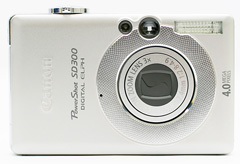 |
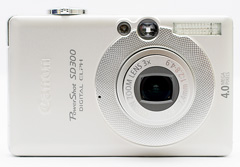 |
| Click images to enlarge. | |
The front of the SD300 features a 3x optical zoom lens that has a 35mm equivalent range of 35 - 105mm. When the camera is powered on, the built-in lens cover opens and the lens extends. Directly above the lens is the viewfinder window. To the left is the AF-assist lamp, which also acts as the red-eye reduction and self-timer lamp. At the upper-right is the thin, built-in flash with a working range of 1.6' - 11.5' at wide angle and 1.6' - 6.6' at telephoto. Just to the left of the lens is a tiny microphone.
The back of the SD300 features a large 2.0" LCD monitor. Directly above the LCD monitor is the viewfinder. It is nice to see that Canon continues to put an optical viewfinder on their ultra-compact cameras. It offers a great way to save battery power (by disabling the LCD). To the right of the viewfinder are two indicator lamps. The top lamp indicates when the camera is ready to shoot or is writing to the SD card. The bottom lamp indicates macro/infinity mode, AF lock, or focus difficulty. On the right side of the LCD monitor are all the main camera controls. Starting at the top is the Mode Switch, which has three positions: Play, Movie, and Record. Below the Mode Switch is the Menu button and a 4-way controller with a separate "Func./Set" button in the middle. In addition to menu navigation, each direction on the 4-way controller corresponds to specific options. Below the 4-way controller is a Display and Print/Share button. A blue light in the Print/Share button activates when the camera is connected to a printer or computer.
The main power button is located on the top of the camera in the form of an On/Off button. A green lamp will light just below the button to indicate that the power is on. To the right of this is the zoom controller with the shutter button in the middle.
 |
 |
| Click images to enlarge. | |
Located on the bottom of the camera is a sliding hinged door that conceals the battery and SD card. We found this door to be fairly weak as it is made out of plastic. It certainly must be handled with more care than the rest of the body. The SD300 is bundled with an NB-4L Li-ion battery (3.7V 760 mAh) and 90-minute wall charger. To release the battery, you must slide a small clip to the side. The camera also comes with a 16MB SD card, but you will most likely want to upgrade to a larger capacity as the included card will only hold a handful of high resolution images. Directly in line with the lens is a metal tripod mount.
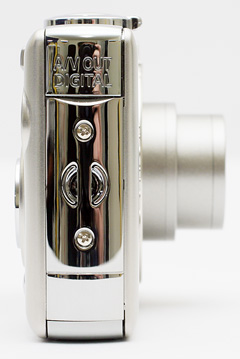 |
 |
| Click images to enlarge. | |
The right side of the camera features a plastic terminal cover that conceals the USB and A/V connections. You will probably need a fingernail to open this cover as it is flush with the side of the body. Below this terminal cover is the post for the included wrist strap.
There's nothing to see on this side, but some screws holding the metal body together.
Overall, we are very impressed with the design of the SD300. The camera is very small and light at only 4.6 oz. In fact, we forgot frequently that we had it in our pocket while we were walking around. The metal body gives it a solid and robust feel.


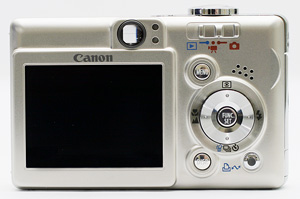
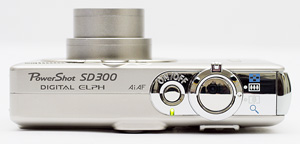
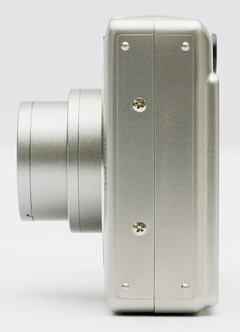








30 Comments
View All Comments
ElFenix - Thursday, February 24, 2005 - link
your title is funnybest [class] camera in its class?
=)
nice review, otherwise. i really want a small camera for parties, etc. my S40 takes up too much space in my pocket, along with my cell phone.
TrueWisdom - Thursday, February 24, 2005 - link
I'm of the opinion that the Casio EXILIM series are better cameras than these. I have the Z-55 and it's the speediest 5MP ultracompact I've come in contact with. I'd like to see Anandtech do a review of the Z-40, Z-50, Z-55, and the EX-S100 to see how they stack up.drwho9437 - Thursday, February 24, 2005 - link
Quasi review:I have an SD200 which is the same camera apart from the sensor, (3.2 instead of 4, save 100 dollars). Things to note about the SDX00 series (new 400, and 500 were introduced).
Firstly, there are more CAs then the average digital (purple fringing), quite alot of it looks to be blooming (ie leakage charging). The lens is definatly soft in the corners, this seems to be the most distrubing when you have something with random high detail, ie tree branches, but not so bad when you have uniform high detail, say grass.
These cameras are said not to have an aperture, instead, they are said to have a ND filter, to cut the light in half. There have been some comments that corner softness in lessed when the camera decides to shoot at a high "aperture" but I have not confired them. The camera itself does not display the shutter speed or aperture even in review mode so its difficult to do that test.
On the flipside I did notice corner softness decrease as focal length increased (probably because that really works like an aperture, it uses just the center of the lens at tele), so if you want a really sharp picture of something standback and zoom in. (I never thought I'd say that).
The video mode is good, but you'll need a fast SD card to do it at 640X480 30fps consistently. The one I have is borderline, and depends what I am taking it of, a little ! warns the buffer is getting full. However 320X240 modes always works for those really long videos at need, if your card ends up not being quite fast enough.
So it is clear I got this camera, so that I would always have a camera with me, I have SLRs for the good stuff, I new about most of the issues I mentioned before I got it, most of them can be worked around.
The highest prase I can give it is I didn't return it.
Souka - Thursday, February 24, 2005 - link
I have a Canon S300 (over 3 years old...) and I'm looking to replace it.I really really like the S410, but once I saw the SD300 I was hooked, the DigiII chip speed rocks.
Well alomst hooked.... The point of a camera is to take pictures....good pictures in my opinion.
The SD300 does a good job, but the flare from flashes and the purple fringing are horrible. I've compared side-by-side shots of my S300 to the SD300. My old S300 takes MUCH better pictures despite 1/2 the resolution (and twice the weight and size!.....but if I wanted to enlarge a print...to lets say 8x10...the SD300 is better.
I guess the S410 is my best option for now.... I'll live with the puny LCD and useless video mode....it's a camera damnit, not a vide camera.
Anyhow.... maybe the SD310 will be better? (A guess)
Cheers....
stephencaston - Thursday, February 24, 2005 - link
#12, I agree with #14. Unless you really need the extra MP, I would go with the SD300 for its speed. If you really want a 5 MP ultra-compact, it might be worth waiting until the SD400 becomes available.R3MF - Thursday, February 24, 2005 - link
@ #6cheers, i didn't know that. :)
tyipengr - Thursday, February 24, 2005 - link
Sorry for the blank post earlier...#12-
I considered the same two cameras before ultimately purchasing the SD300. The speed of the Digic II, the vastly superior movie mode, and the 2-in. LCD got me at the end. I personally do not edit pictures very much so the extra 1-MP isn't as important to me. 4 MP is enough for 8x10s which is the largest I will ever blow up a pic.
tyipengr - Thursday, February 24, 2005 - link
brownba - Thursday, February 24, 2005 - link
Stephen: I'm looking to buy a camera for my wedding this summer. I'm sure it'll be one of the canon elph's. The S500 is almost the same price as this SD300, which would you recommend? or just in general, which ultra-compact would you recommend?sxr7171 - Thursday, February 24, 2005 - link
I have this camera and it probably is the top digital camera in its size class. There are some downsides to having such a small camera especially with regard to the purple fringing, and some of the graininess in night shots (due to the tiny photosensor), but it has some crazy attributes that make an amazing camera. One is the unreal speed of this thing. It is ready to take pictures within a second of turning on and it takes pictures with almost no delay at all when already powered on. It also has unreal battery life. I tested it once at home by taking 50% flash shots continuously in rapid-fire mode and it took over 1700 shots before the battery died. These things make it almost flawless for its main purpose - to take a bunch of casual pictures when on vacation without worrying about the battery dying and to get the shot you want without losing it while the camera is still trying to focus/turn on/bring the lens out etc.Does anyone know if there is a way to reduce the oversharping though? I'm not too happy about that. I know the Digital Rebel comes with sharpness set a little high by default but they allow you to reduce back to the EOS-10D/20D default levels.